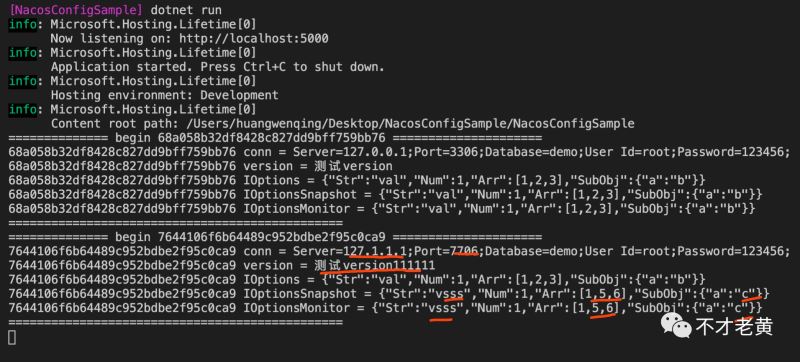背景
之前老黃寫過一篇《ASP.NET Core結合Nacos來完成配置管理和服務發現》簡單介紹了如何讓.NET Core程序接入Nacos,之前的SDK里面更多的是對Nacos的Open API進行了封裝以及對服務注冊和發現的封裝。
配置這一塊當時并沒有過多的處理,用起來有時感覺不會特別順手,所以將它和.NET Core的配置結合起來了,讓它用起來更簡便。
怎么個簡便法呢?
可以說,除了多添加一下provider,其他的操作都是和最原始的一模一樣,你想用IConfiguration就用IConfiguration,想用IOptions系列就用IOptions系列。
更容易做到無縫遷移!
當然,這個SDK出自老黃的手,難免會有一些坑和bug,這個就請各位多多包涵!!
前提條件
啟動Nacos Server
最簡單的方式,用docker啟動一個單機版的。
|
1
|
docker-compose -f example/standalone-mysql-8.yaml up |
創建一個.NET Core項目,并安裝相應nuget包
這里將用ASP.NET Core Web Api做示例,同時要安裝下面的nuget包
|
1
|
dotnet add package nacos-sdk-csharp-unofficial.Extensions.Configuration --version 0.2.6 |
更直接點,直接修改csproj
|
1
2
3
|
<ItemGroup> <PackageReference Include="nacos-sdk-csharp-unofficial.Extensions.Configuration" Version="0.2.6" /></ItemGroup> |
進行配置
打開Program.cs,在CreateHostBuilder加入Nacos的provider配置,都是Nacos的一些基礎配置。
|
1
2
3
4
5
6
7
8
9
10
11
12
13
14
15
16
17
18
19
20
21
22
23
24
25
26
27
28
29
|
public static IHostBuilder CreateHostBuilder(string[] args) => Host.CreateDefaultBuilder(args) .ConfigureAppConfiguration((context, builder) => { var c = builder.Build(); var dataId = c.GetValue<string>("nacosconfig:DataId"); var group = c.GetValue<string>("nacosconfig:Group"); var tenant = c.GetValue<string>("nacosconfig:Tenant"); var optional = c.GetValue<bool>("nacosconfig:Optional"); var serverAddresses = c.GetSection("nacosconfig:ServerAddresses").Get<List<string>>(); // 0.2.6版本之前,只支持這種方式 builder.AddNacosConfiguration(x => { x.DataId = dataId; x.Group = group; x.Tenant = tenant; x.Optional = optional; x.ServerAddresses = serverAddresses; }); //// 0.2.6版本之后可以從配置文件讀取Nacos的基本配置 //builder.AddNacosConfiguration(c.GetSection("nacosconfig")); }) .ConfigureWebHostDefaults(webBuilder => { webBuilder.UseStartup<Startup>(); }); |
同樣的,我們還要修改appsettings.json,把Nacos的配置寫進去,主要是用來區分不同環境的配置來源。
|
1
2
3
4
5
6
7
8
9
10
11
12
13
14
15
16
|
{ "Logging": { "LogLevel": { "Default": "Warning", "Microsoft": "Warning", "Microsoft.Hosting.Lifetime" :"Information" } }, "nacosconfig":{ "Optional": false, "DataId": "msconfigapp", "Group": "", "Tenant": "ca31c37e-478c-46ed-b7ea-d0ebaa080221", "ServerAddresses": ["localhost:8848"] }} |
好了,到這里,用于配置Nacos相關的內容就結束了。接下來,要做的就是在nacos控制臺進行配置的維護。
配置使用
新建一個配置

添加一個對應的實體類
|
1
2
3
4
5
6
7
8
9
10
11
12
13
14
15
|
public class AppSettings{ public string Str { get; set; } public int Num { get; set; } public List<int> Arr { get; set; } public SubObj SubObj { get; set; }}public class SubObj{ public string a { get; set; }} |
因為要驗證IOptions模式,所以要在Startup中加點代碼
|
1
2
3
4
5
|
public void ConfigureServices(IServiceCollection services){ services.Configure<AppSettings>(Configuration.GetSection("AppSettings")); services.AddControllers();} |
下面就是真正的使用了!
|
1
2
3
4
5
6
7
8
9
10
11
12
13
14
15
16
17
18
19
20
21
22
23
24
25
26
27
28
29
30
31
32
33
34
35
36
37
38
39
40
41
42
43
44
45
46
47
48
49
|
[ApiController][Route("api/[controller]")]public class ConfigController : ControllerBase{ private readonly IConfiguration _configuration; private readonly AppSettings _settings; private readonly AppSettings _sSettings; private readonly AppSettings _mSettings; public ConfigController( IConfiguration configuration, IOptions<AppSettings> options, IOptionsSnapshot<AppSettings> sOptions, IOptionsMonitor<AppSettings> _mOptions ) { _configuration = configuration; _settings = options.Value; _sSettings = sOptions.Value; _mSettings = _mOptions.CurrentValue; } [HttpGet] public string Get() { string id = Guid.NewGuid().ToString("N"); Console.WriteLine($"============== begin {id} ====================="); var conn = _configuration.GetConnectionString("Default"); Console.WriteLine($"{id} conn = {conn}"); var version = _configuration["version"]; Console.WriteLine($"{id} version = {version}"); var str1 = Newtonsoft.Json.JsonConvert.SerializeObject(_settings); Console.WriteLine($"{id} IOptions = {str1}"); var str2 = Newtonsoft.Json.JsonConvert.SerializeObject(_sSettings); Console.WriteLine($"{id} IOptionsSnapshot = {str2}"); var str3 = Newtonsoft.Json.JsonConvert.SerializeObject(_mSettings); Console.WriteLine($"{id} IOptionsMonitor = {str3}"); Console.WriteLine($"==============================================="); return "ok"; }} |
從上面的代碼,看上去應該熟悉的不能再熟悉了吧!這些配置的用法,就是.NET Core里面提供的最原始的,原汁原味。
啟動訪問這個接口,可以看到下面的輸出。

在控制臺修改這個配置。

再次訪問,可以發現,除了IOptions之外,都讀取到了新的配置。

之所以IOptions沒有獲取到最新的配置,那是因為它的默認實現不會進行更新操作,也就是從啟動到結束,它都是不會變的。
在有配置變更的情景,請盡可能不要用IOptions,用IOptionsSnapshot和IOptionsMonitor來替代!
總結
這里介紹了如何讓.NET Core更容易對接Nacos配置的方法,希望對各位有所幫助。
到此這篇關于在.NET Core中用最原生的方式讀取Nacos的配置的文章就介紹到這了,更多相關.NET Core讀取Nacos的配置內容請搜索服務器之家以前的文章或繼續瀏覽下面的相關文章希望大家以后多多支持服務器之家!
原文鏈接:https://www.cnblogs.com/catcher1994/p/12776725.html












